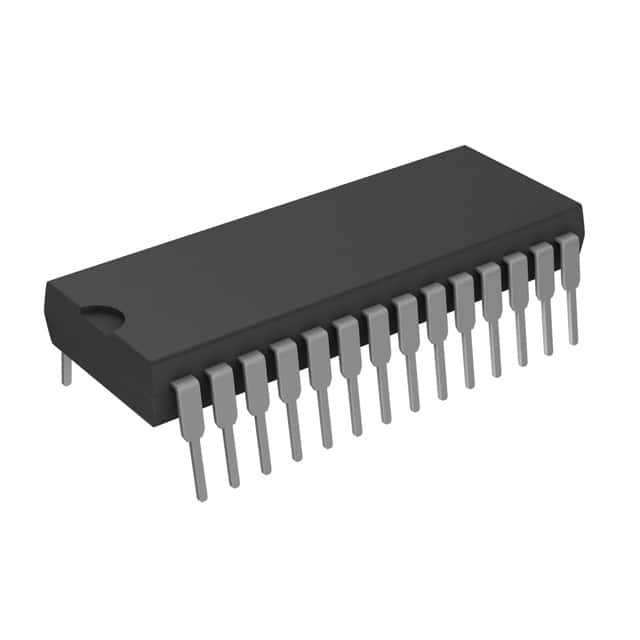AT28C64X-25PI
Product Overview
Category
AT28C64X-25PI belongs to the category of non-volatile memory devices.
Use
It is primarily used for storing and retrieving digital information in electronic systems.
Characteristics
- Non-volatile: The stored data is retained even when power is removed.
- High capacity: The AT28C64X-25PI has a storage capacity of 64 kilobits (8 kilobytes).
- Fast access time: It operates at a speed of 250 nanoseconds, allowing for quick data retrieval.
- Low power consumption: The device is designed to minimize power usage, making it suitable for battery-powered applications.
Package
The AT28C64X-25PI is available in a 28-pin plastic dual in-line package (PDIP).
Essence
The essence of AT28C64X-25PI lies in its ability to provide reliable and non-volatile storage for electronic systems.
Packaging/Quantity
The device is typically packaged in tubes or trays, with each tube or tray containing a specific quantity of AT28C64X-25PI chips. The exact quantity may vary depending on the manufacturer's specifications.
Specifications
- Operating voltage: 5V
- Organization: 8K x 8 bits
- Access time: 250 ns
- Standby current: 100 µA (max)
- Operating temperature range: -40°C to +85°C
- Data retention: 10 years (minimum)
Detailed Pin Configuration
The AT28C64X-25PI has a total of 28 pins, each serving a specific purpose. Here is the detailed pin configuration:
- A0-A12: Address inputs
- CE: Chip Enable
- OE: Output Enable
- WE: Write Enable
- I/O0-I/O7: Data input/output
- VCC: Power supply (5V)
- GND: Ground
Functional Features
- Random access: The device allows for random access to any location within its memory space.
- Byte-wise programming: It supports byte-wise programming, enabling efficient data storage and retrieval.
- Hardware data protection: The AT28C64X-25PI includes hardware features to protect stored data from accidental modification.
Advantages and Disadvantages
Advantages
- Non-volatile storage: The data remains intact even in the absence of power.
- High capacity: Ample storage space for various applications.
- Fast access time: Quick retrieval of data.
- Low power consumption: Suitable for battery-powered devices.
Disadvantages
- Limited rewrite cycles: The device has a finite number of write cycles before it may become unreliable.
- Relatively larger package size: The 28-pin PDIP package may require more board space compared to smaller form factors.
Working Principles
The AT28C64X-25PI utilizes electrically erasable programmable read-only memory (EEPROM) technology. It stores data by trapping electrical charges within floating gate transistors. These charges can be selectively removed or added using specific voltage levels, allowing for data programming and erasure.
Detailed Application Field Plans
The AT28C64X-25PI finds application in various electronic systems, including but not limited to: - Microcontrollers - Embedded systems - Industrial control systems - Automotive electronics - Communication devices
Detailed and Complete Alternative Models
- AT28C64B-15PU: Similar specifications with a lower access time of 150 ns.
- AT28C256-15PU: Higher capacity (256 kilobits) with similar characteristics and pin configuration.
- AT28HC256E-90PU: Extended temperature range (-40°C to +125°C) with a capacity of 256 kilobits.
These alternative models offer different specifications and features, allowing users to choose the most suitable option for their specific requirements.
In conclusion, the AT28C64X-25PI is a non-volatile memory device that provides reliable storage for electronic systems. With its high capacity, fast access time, and low power consumption, it is well-suited for various applications. However, it has limitations such as limited rewrite cycles and a relatively larger package size. Understanding its working principles and considering alternative models can help users make informed decisions when incorporating this device into their designs.
Lista 10 Vanliga frågor och svar relaterade till tillämpningen av AT28C64X-25PI i tekniska lösningar
Sure! Here are 10 common questions and answers related to the application of AT28C64X-25PI in technical solutions:
Q: What is the AT28C64X-25PI? A: The AT28C64X-25PI is a high-performance, low-power CMOS 64K EEPROM (Electrically Erasable Programmable Read-Only Memory) chip.
Q: What is the operating voltage range for the AT28C64X-25PI? A: The AT28C64X-25PI operates within a voltage range of 2.7V to 5.5V.
Q: What is the maximum clock frequency supported by the AT28C64X-25PI? A: The AT28C64X-25PI supports a maximum clock frequency of 250 kHz.
Q: Can the AT28C64X-25PI be used for code storage in microcontroller-based systems? A: Yes, the AT28C64X-25PI can be used for code storage in microcontroller-based systems as it provides non-volatile memory storage.
Q: How many bytes of data can the AT28C64X-25PI store? A: The AT28C64X-25PI can store up to 64 kilobytes (64K) of data.
Q: Is the AT28C64X-25PI capable of byte-level read and write operations? A: Yes, the AT28C64X-25PI supports byte-level read and write operations, allowing for efficient data manipulation.
Q: Does the AT28C64X-25PI support multiple erase cycles? A: Yes, the AT28C64X-25PI supports multiple erase cycles, making it suitable for applications that require frequent data updates.
Q: Can the AT28C64X-25PI operate in harsh environmental conditions? A: Yes, the AT28C64X-25PI is designed to operate reliably in a wide temperature range (-40°C to +85°C) and can withstand high levels of shock and vibration.
Q: Are there any special considerations for programming the AT28C64X-25PI? A: Yes, the AT28C64X-25PI requires a specific programming algorithm and voltage levels to ensure proper operation. The datasheet provides detailed instructions.
Q: What are some typical applications of the AT28C64X-25PI? A: The AT28C64X-25PI is commonly used in various technical solutions such as embedded systems, industrial control systems, automotive electronics, and consumer electronics where non-volatile memory storage is required.
Please note that these answers are general and may vary depending on the specific requirements and use cases. It's always recommended to refer to the datasheet and consult with technical experts for accurate information.


